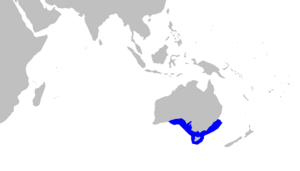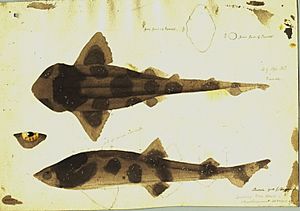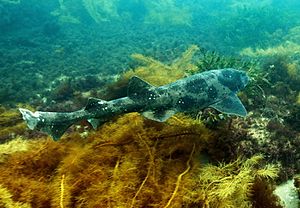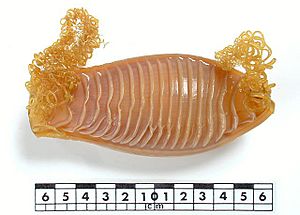Australian swellshark facts for kids
Quick facts for kids Australian swellshark |
|
|---|---|
 |
|
| Conservation status | |
| Scientific classification | |
| Genus: |
Cephaloscyllium
|
| Species: |
laticeps
|
 |
|
| Range of the Australian swellshark | |
| Synonyms | |
|
Cephaloscyllium nascione Whitley, 1932 |
|
The Australian swellshark (Cephaloscyllium laticeps), also called the draughtboard shark, is a type of catshark. It belongs to the Scyliorhinidae family. This shark is found only in southern Australia.
It lives on the continental shelf, usually on the ocean floor. You can find it as deep as 220 meters (720 feet). This shark is often about 1 meter (3 feet) long. It has a strong body and a wide head. Its first dorsal fin is much bigger than its second. You can spot it by its brown or gray patches and many spots.
Australian swellsharks do not move around much. They are mostly active at night. Most of them stay in the same area all year. They eat small crustaceans, cephalopods, and fishes. When scared, they quickly take in water or air. This makes their body swell up, which is why they are called "swellsharks."
This shark lays eggs. Females lay pairs of special egg capsules every 20 to 30 days. These eggs hatch after 11 to 12 months. Australian swellsharks are harmless to humans. They are not often caught for food. Many are caught by accident in fishing nets. But they usually survive because they are very tough. Because of this, the International Union for the Conservation of Nature (IUCN) says this species is of Least Concern.
Contents
About the Australian Swellshark Name
The first scientific description of the Australian swellshark was in 1853. It was named Scyllium laticeps by French zoologist Auguste Duméril. The first shark studied was a 79 cm (31 inch) male from Tasmania.
The name laticeps comes from Latin words. Latus means "broad," and ceps means "head." This refers to the shark's wide head. Other common names for this shark include flopguts, nutcracker shark, and sleepy Joe.
This shark looks very much like the draughtsboard shark (C. isabellum) from New Zealand. The main differences are their colors and their egg cases. The Australian swellshark has ridged egg cases, while the draughtsboard shark has smooth ones.
What the Australian Swellshark Looks Like
The Australian swellshark has a strong, rounded body. It gets much thinner towards its short tail. Its head is wide and a bit flat. The snout (nose area) is short and blunt.
Its nostrils have small flaps of skin. The mouth is very large with no grooves at the corners. It has many small teeth with several points. The upper teeth can be seen even when its mouth is closed. Its large, oval eyes are on top of its head. They have small protective eyelids.
This shark has two dorsal fins. The first one is much larger than the second. The first dorsal fin starts above the front of the pelvic fins. The second dorsal fin is above the anal fin. The pectoral fins are large and wide. The anal fin is bigger than the second dorsal fin.
The caudal fin (tail fin) is short and wide. It has a small lower part and a notch near the tip of the upper part. The shark's skin is thick. It is covered in small, arrowhead-shaped scales.
Its back and sides are light gray to brown. They have dark patches and many dark spots. There is also a dark stripe from under the eye to the pectoral fins. The fins do not have sharp light edges. The underside is cream-colored. Adults often have a dark stripe down the middle of their belly. The largest known Australian swellshark was 1.5 meters (5 feet) long. However, most are not longer than 1 meter (3 feet).
Where Australian Swellsharks Live
The Australian swellshark lives on the continental shelf of southern Australia. You can find it from the Recherche Archipelago in Western Australia to Jervis Bay in New South Wales. This includes Tasmania.
It often lives on or near the bottom. It likes rocky reefs or areas with seaweed beds. It can be found close to shore or as deep as 220 meters (720 feet).
Australian Swellshark Behavior and Diet
The Australian swellshark is the most common catshark in southern Australia. It is usually a slow swimmer. It is more active at night. During the day, it often rests alone or in groups. They hide under ledges or inside caves.
Studies show that some sharks are active for months. Others rest for up to five days. Most Australian swellsharks stay in the same area all year. They visit their favorite feeding spots or homes. But some sharks have traveled up to 300 km (186 miles). This shark is very tough. It can even live for more than a day out of water.
The Australian swellshark is a top predator in its ecosystem. It eats crustaceans, like crabs and rock lobsters. It also eats cephalopods, such as squid and octopus, and small fishes. They often swallow large prey whole. The long rest periods some sharks take might be for digestion.
Like other swellsharks, this shark can quickly inflate its body. It does this by taking in water or air into its stomach. This is a defense against predators. Larger fish, like the broadnose sevengill shark, and marine mammals can be predators. By swelling up, the shark might get stuck in small spaces. It also makes itself harder to swallow or scares away a predator. Marine snails are known to eat this shark's eggs. The Australian swellshark can have parasites, but not much is known about them.
Australian Swellshark Life Cycle
The Australian swellshark lays eggs. Males have bigger teeth than females. They use these teeth to hold onto the female during mating. We are not sure if they have a special mating season. However, males can produce sperm all year.
Females have one working ovary and two oviducts. They lay one egg in each at a time. They can store sperm for at least 15 months. Females lay eggs throughout the year. They lay pairs of eggs about every 20 days from January to June. For the rest of the year, they lay eggs about every 30 days. The second egg in a pair is laid 12 to 24 hours after the first.
The egg capsules are pale and shaped like a flask. They are about 13 cm (5 inches) long and 5 cm (2 inches) wide. They have 19 to 27 ridges across them. There are long, curly threads at the four corners. These threads help the female attach the egg capsule to seaweed or other things on the ocean floor.
In tanks, the baby shark inside the egg grows external gills at two months old. It keeps these until it is five months old. Then, its internal gills take over, and its first colors appear. At six months, the baby shark grows faster. The yolk sac, which provides food, starts to shrink. It disappears by nine to ten months of age.
The eggs usually hatch after 11 to 12 months. The new young sharks are tiny versions of the adults. They are about 14 cm (5.5 inches) long when they hatch. Males become ready to breed when they are 71 to 87 cm (28 to 34 inches) long. Females are ready when they are 75 to 86 cm (30 to 34 inches) long.
Australian Swellsharks and Humans
The Australian swellshark is not dangerous to people. It is not often used for food. But recently, in parts of Tasmania, some are sold as "flake" (a type of fish meat). Lobster fishers sometimes find them annoying. This is because the sharks swim into traps to eat the lobsters.
Many Australian swellsharks are caught by accident each year. This happens in fishing nets and on longlines in southeast Australia. These sharks are usually released. They likely survive because they are very tough. Since this shark is not in much danger from fishing, the International Union for the Conservation of Nature (IUCN) lists it as Least Concern.
Even though fishing reports showed fewer catches from 1973 to 1976 and 1998 to 2001, this was likely due to changes in fishing habits, not fewer sharks. Still, as a safety step, the government of Tasmania has set limits. People can only catch two sharks per person or five sharks per boat each day.
See also
 In Spanish: Cephaloscyllium laticeps para niños
In Spanish: Cephaloscyllium laticeps para niños





